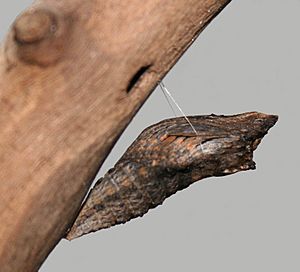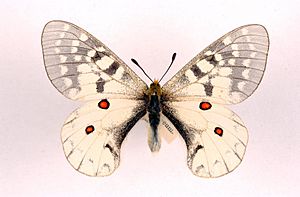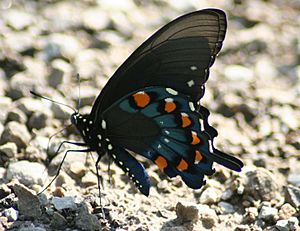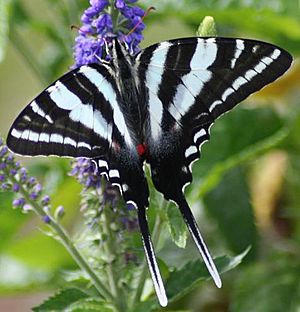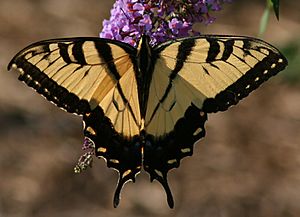List of butterflies of North America (Papilionidae) facts for kids
Swallowtails are some of the biggest butterflies in the world! They can be anywhere from about 2.5 to 6.5 inches (6.5 to 16.5 cm) wide. There are around 600 different kinds of swallowtails globally. About 31 of these species live right here in North America.
Most swallowtails have special "tails" on their back wings. These look a bit like tiny streamers. The only ones without these tails are a group called parnassians. Swallowtails usually fly slowly and smoothly, almost like they are gliding. But if they feel scared or bothered, they can fly very fast and strongly!
These butterflies love to sip nectar from many different flowers. They also get important nutrients from damp ground, like puddles. Male swallowtails often gather in groups on wet soil. This is called "mud-puddling," and it helps them get minerals they need. Most male swallowtails find females by flying around and looking for them. Some males also wait in one spot, watching for females to fly by.
Contents
The Amazing Life Cycle of a Swallowtail
Swallowtail butterflies go through a complete life cycle, just like all butterflies. It's a fascinating journey from egg to adult!
Eggs and Larvae (Caterpillars)
Swallowtail eggs are usually round. The female butterfly lays them one at a time on different kinds of plants. These plants are called "host plants" because they are what the young caterpillars will eat.
When the eggs hatch, tiny caterpillars (larvae) emerge. These young caterpillars have a clever defense mechanism. If they get scared, they can push out a reddish-orange, forked gland from behind their head. This gland is called an osmeterium. It releases a stinky smell that can scare away predators!
Many young swallowtail caterpillars also have a cool trick: they look like bird droppings. This helps them hide from birds and other animals that might want to eat them.
The Chrysalis Stage
After growing big enough, the caterpillar forms a chrysalis. This is like a special case where the caterpillar transforms into a butterfly. Most swallowtail chrysalises are brown or green. They often look just like a leaf or a small branch. This helps them blend in and stay safe from predators.
The chrysalis is held upright by a silky loop around its middle. This loop is called a girdle. Swallowtails usually spend the winter months in this chrysalis stage. They wait there until the weather gets warmer, and then they emerge as beautiful adult butterflies.
Types of Swallowtail Butterflies
There are two main groups, or subfamilies, of swallowtails found in North America: the parnassians and the true swallowtails.
Parnassians: The Tailless Wonders
Parnassians are a unique group because they are the only swallowtails that do not have tails on their hindwings. They are often found in mountainous areas.
Some examples of parnassians in North America include:
- Clodius parnassian (Parnassius clodius)
- Eversmann's parnassian (Parnassius eversmanni)
- Phoebus parnassian (Parnassius phoebus)
Papilioninae: The True Swallowtails
This subfamily includes most of the swallowtails you might recognize, famous for their distinctive tails. They come in many different colors and patterns.
Here are a few well-known examples:
- Pipevine swallowtail (Battus philenor)
- Zebra swallowtail (Protographium marcellus)
- Eastern tiger swallowtail (Papilio glaucus)
- Black swallowtail (Papilio polyxenes)
- Giant swallowtail (Papilio cresphontes)
- Spicebush swallowtail (Papilio troilus)
These are just a few of the many amazing swallowtail species that call North America home!


